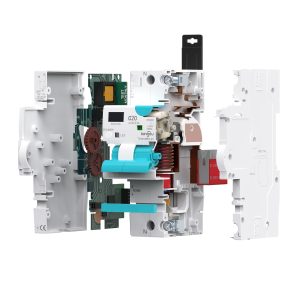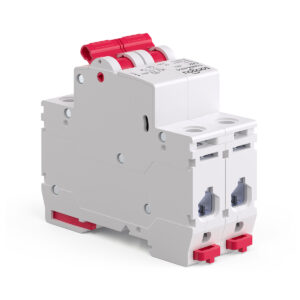
RCBO Trips at Night? Causes, Diagnosis, and Lasting Fixes
RCBO Trips at Night? Causes, Diagnosis, and Lasting Fixes Already know what an RCBO is? Great. This page skips the basics and focuses on nocturnal
Confused about the difference between Type A and Type AC RCBOs? You’re not alone. As a critical component for electrical safety, choosing the correct RCBO type is not just a matter of compliance—it’s essential for protecting lives and property. With modern electronics now in nearly every appliance, the once-standard Type AC is often no longer sufficient.
This expert guide will clearly explain the crucial differences, show you why a Type A RCBO is now the professional standard for most applications, and help you make a safe, informed decision that aligns with current international wiring regulations.
Function: Both types protect against earth leakage and overcurrents.
Type AC: Only detects standard sinusoidal AC fault currents. Suitable for older, simple circuits (e.g., filament bulbs, basic heaters). It is now considered outdated for most modern applications.
Type A: Detects both AC faults and the pulsating DC faults generated by modern electronic appliances (washing machines, LED drivers, computers).
The Rule: If the circuit has socket outlets or powers ANY modern electronic device, Type A is the mandatory choice for safety and compliance.
Expert Verdict: For all new installations and upgrades, a Type A RCBO is the professional standard. The minimal cost difference is negligible compared to the significant increase in safety.
Recent Acticle: RCBO Meaning, Application and FAQ
An RCBO combines the functionality of two crucial safety devices:
Residual Current Device (RCD) / Residual Current Circuit Breaker (RCCB): Detects imbalances in current flow between the live and neutral conductors, indicating an earth leakage (e.g., current flowing through a person). It trips to prevent electrocution.
Miniature Circuit Breaker (MCB): Protects the circuit wiring from damage due to overloads (drawing too much current) or short circuits.
By integrating both, an RCBO provides comprehensive protection in a single unit, saving space in consumer units/distribution boards.

Detection Capability: Type AC RCBOs are designed to detect and trip only on sinusoidal alternating residual currents.
Symbol: You’ll often see a sine wave symbol (∼) within a box on a Type AC device.
Historical Context & Application: For many years, Type AC devices were the standard. They are suitable for circuits supplying loads that, if they develop a fault, will only produce a sinusoidal AC earth leakage current. This typically includes:
——Older installations with purely resistive loads (e.g., conventional filament lighting, electric heaters without electronic controls).
——Appliances with no electronic components.
Limitations: The major drawback of Type AC RCBOs is their inability to reliably detect pulsating DC residual currents. If an appliance with electronic components (e.g., a modern washing machine, dishwasher, LED driver) develops a fault that results in a pulsating DC leakage, a Type AC RCBO might fail to trip, or its tripping characteristics might be compromised. This phenomenon is sometimes called “blinding,” where the DC component can saturate the RCBO’s sensing core.

Detection Capability: Type A RCBOs are designed to detect and trip on:
——Sinusoidal alternating residual currents (like Type AC).
——Pulsating DC residual currents.
——Pulsating DC residual currents superimposed on a smooth DC current of up to 6mA.
Symbol: The symbol for Type A typically includes the sine wave (∼) and also two half-rectified waves or a similar representation of pulsating DC detection.
Why They Are Necessary: Modern life is filled with electronic devices. From your washing machine and dishwasher to your computer, LED lighting drivers, and phone chargers, many contain rectifiers, choppers, or phase angle controls. These components can generate pulsating DC fault currents.
Typical Applications: Type A RCBOs are essential for circuits supplying:
——Appliances with electronic components (e.g., washing machines, tumble dryers, dishwashers, induction hobs).
——Single-phase inverters.
——IT equipment (Class 1).
——Lighting circuits with dimmers or LED drivers.
——Electric vehicle (EV) charging points (though some EV chargers may require Type B).
Advantages: Type A RCBOs offer a significantly higher level of safety in modern installations where electronic loads are prevalent.

RCBO Applications
| Feature | Type AC RCBO | Type A RCBO |
| Detects AC | Yes | Yes |
| Detects Pulsating DC | No (or unreliable detection) | Yes |
| Suitability | Older circuits, purely resistive/inductive loads | Modern circuits with electronic appliances, LED lighting, IT equipment |
| Cost | Generally Lower | Generally Higher (but safety justifies the cost) |
| Safety Level | Basic | Enhanced, suitable for most modern residential & commercial applications |
| Future-Proofing | Limited | Good, aligns with modern appliance technology |

The UK has seen a strong shift towards Type A RCBOs.
BS 7671 (currently 18th Edition with amendments) heavily implies, and in many cases effectively mandates, the use of Type A (or better, like Type F or B for specific loads) for most new circuits or when replacing RCDs/RCBOs on circuits feeding equipment likely to produce pulsating DC.
Type AC devices are generally considered unsuitable for circuits supplying socket outlets or any equipment that could produce DC components. Their use is increasingly restricted to very specific, legacy applications.
For EV charging, specific requirements often point towards Type A (with 6mA DC detection if not integral to the charger) or Type B.
Many European countries follow CENELEC standards, which are aligned with IEC standards.
There’s a general trend across Europe to favor Type A RCBOs for broader protection, especially in new installations.
National regulations within individual EU countries (e.g., Germany’s VDE, France’s NF C 15-100) will specify the exact requirements. Some countries may have already phased out Type AC for general use.
Similar to the UK and Europe, there’s an increasing recognition of the need for RCDs that can handle pulsating DC.
Type A RCDs/RCBOs are becoming the de-facto standard for many applications to ensure compatibility with modern appliances.
The RCD landscape is different. Ground Fault Circuit Interrupters (GFCIs) are the primary devices for personnel protection against earth leakage. GFCIs in North America are generally designed to operate on AC and have some inherent capability to detect certain types of DC faults, but their “Type” classification isn’t directly equivalent to IEC Type A/AC. Arc Fault Circuit Interrupters (AFCIs) are also mandated for many circuits to protect against arcing faults.
While direct comparison is complex, the principle of ensuring protection against various fault current waveforms is universally important.
Important Note: Electrical regulations are subject to change. Always consult the latest version of your local electrical code and a qualified electrician to ensure compliance and safety.
Does it power socket outlets? If yes, you must use Type A. You cannot predict what will be plugged in.
Does it power ANY electronic device? (e.g., washing machine, dishwasher, computer, LED driver, modern furnace, heat pump). If yes, you must use Type A.
Is it for simple, non-electronic loads ONLY? (e.g., a dedicated circuit for a simple electric resistance heater or filament bulbs). A Type AC might be permissible, but proceed to step 2.
Consult the latest version of your country’s wiring regulations (e.g., BS 7671, AS/NZS 3000). Many have already made Type A the mandatory minimum for most circuits, especially new installations.
Appliances are always updated. The simple heater you install today might be replaced with a smart, electronically controlled model tomorrow. Installing a Type A RCBO is a smart, future-proof investment.
When in doubt, always choose Type A. The marginal increase in cost is a tiny price to pay for the significant increase in safety and compatibility with all modern and future devices.
Installing a Type AC on a Kitchen Circuit: This is a frequent error. Modern kitchens are filled with appliances (dishwashers, induction hobs, microwaves) that have electronics. A Type AC RCBO may fail to trip on a fault from one of these devices.
Forgetting About LED Lighting Drivers: Even a simple lighting circuit can produce pulsating DC faults if it uses modern LED drivers or dimmers. Using a Type AC here is a risk.
Assuming “Like-for-Like” Replacement is Always Correct: When replacing a faulty RCBO in an older installation, simply replacing it with the same Type AC model is not always compliant or safe. You must assess the loads on the circuit. If they have changed over the years (which is likely), an upgrade to Type A is necessary.
Ignoring the Needs of EV Chargers: While a Type A RCBO is a baseline, many EV chargers require specific RCD protection (e.g., one with 6mA smooth DC detection or a full Type B RCD). Always follow the EV charger manufacturer’s instructions.

While Type AC RCBOs still exist, their application in modern electrical systems is now extremely limited. The proliferation of electronics means that the pulsating DC fault currents they cannot detect are a constant and growing risk.
For this reason, the Type A RCBO is no longer just an “enhanced” option; it is the essential, professional standard for nearly all residential, commercial, and industrial applications. When specifying, installing, or upgrading a smart or standard RCBO, choosing Type A ensures a higher level of safety, meets the demands of modern technology, and guarantees compliance with today’s stringent electrical codes. Always engage a qualified electrician for installation and advice.

RCBO Trips at Night? Causes, Diagnosis, and Lasting Fixes Already know what an RCBO is? Great. This page skips the basics and focuses on nocturnal

MCB B/C/D Curves in Practice: How Inrush Current Shapes Your Choice This guide assumes you already know what an MCB is. If you need a

SPD Coordination for Solar PV and EV Charging: Where to Place Type 1/2/3 Already know the difference between Type 1/2/3 and AC vs DC SPDs?

MCB vs MCCB: A Practical Guide to Icu/Ics and IEC 60898 vs 60947-2 This guide assumes you already know what a breaker is. If you

tongou was established in 1993 and is the trademark of Changyou Technology. We position ourselves as providers of intelligent product solutions for high and low voltage electrical systems, taking on solving customers’ pressures and challenges as our responsibility and creating value for them. We utilize intelligent products to serve global customers, making life smarter and more convenient to benefit your life.
Paidong Industrial Zone Qiligang,Yueqing City,Zhejiang province,China.
Sales: [email protected]
After-sales: [email protected]
© 2025 Changyou Technology. All Rights Reserved.

